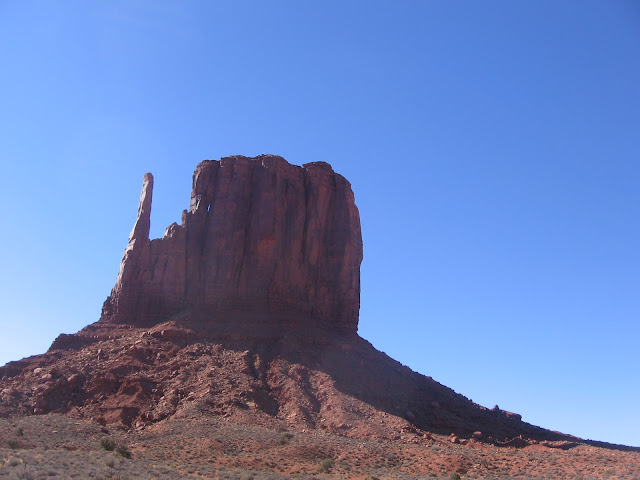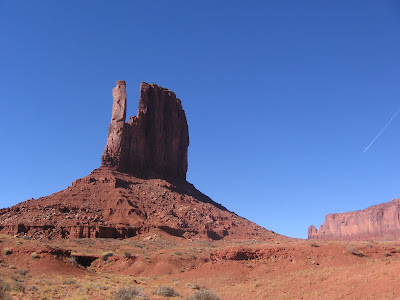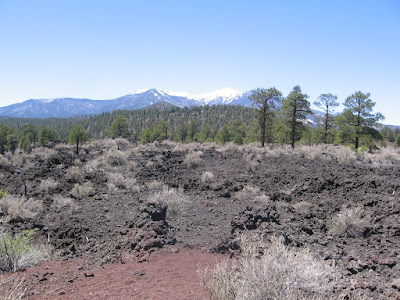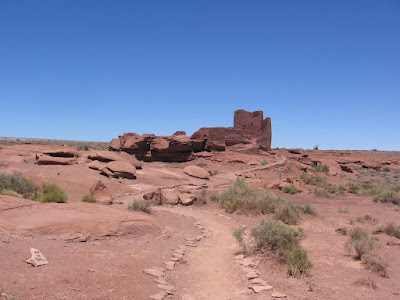John Ford’s Point is the fourth point of interest on the Self Guiding Valley Drive Trail at Monument Valley Tribal Park in the Navajo Nation. Beside the view point, there is a short trail to walk and it is a center for viewing Navajo Arts and Crafts.
John Ford directed more than 140 films and won four Best Director Academy Awards and is regarded as one of the all time best directors. He pioneered location shooting and the long shots framing characters against rugged natural terrain such as here at Monument Valley.
Stagecoach in 1939 was the first in the series of seven Ford Westerns filmed on location in Monument Valley. It was nominated for seven Academy Awards including Best Picture and Best Director. Stagecoach was the film that elevated John Wayne to international stardom. The gift shop at the Visitor Center has several of these films for sale along with an assortment of John Wayne souvenirs.
Looking east, there is a head on view of Camel Butte, the fifth point of interest on the Valley Drive. Beyond is the Spearhead Mesa area that includes Artist’s Point, another major stop and view point.
Back to the west are the Three Sisters and Mitchell Mesa. The geology here is described as three main layers. The caprock Shinarump formation sits on the DeChelly or Cedar Mesa Sandstone that forms the sheer cliffs of the mesas and buttes. The stair steps below the buttes and spires are softer Organ Rock shales.
Part of the charm of John Ford’s Point is the array of Navajo vendors. The silver and turquoise jewelry draw a lot of attention. There is an opportunity to try the famous Navajo tacos featuring the fry bread shells as you gaze out toward Merrick Butte and the famous Mittens.









































 The hike past the Kin Kletso and Casa Chiquita Great House ruins sites and the six or more petroglyph panels is 1.7 miles one way. It is about 1.0 miles more to the Chaco Wash crossing. In mid March after a heavy snow season, the narrow wash was flowing with dark silt laden water. I probed the swirling stream with a Tamarisk stick and found the bottom was very soft and the banks very slippery.
The hike past the Kin Kletso and Casa Chiquita Great House ruins sites and the six or more petroglyph panels is 1.7 miles one way. It is about 1.0 miles more to the Chaco Wash crossing. In mid March after a heavy snow season, the narrow wash was flowing with dark silt laden water. I probed the swirling stream with a Tamarisk stick and found the bottom was very soft and the banks very slippery.

 The trail climbs immediately to the mesa top and follows along the rocky edge. The main point of interest in the east end of Chaco Canyon is Fajada Butte. Fajada means “banded” in Spanish. The Cliff House Sandstone forms the upper layers and the softer Menefee formation the lower. A narrow layer of lignite coal is between the two.
The trail climbs immediately to the mesa top and follows along the rocky edge. The main point of interest in the east end of Chaco Canyon is Fajada Butte. Fajada means “banded” in Spanish. The Cliff House Sandstone forms the upper layers and the softer Menefee formation the lower. A narrow layer of lignite coal is between the two. 
 The site is partially excavated and has about 100 rooms built around a large plaza. This site is thought to have been occupied twice, from 1100 to 1200 and again 1250 to 1380 AD. The Puerco Pueblo sits on the cultural border of the Ancestral Pueblo to the north and the Mogollon to the south. The artifacts found here indicate that both groups made contact here.
The site is partially excavated and has about 100 rooms built around a large plaza. This site is thought to have been occupied twice, from 1100 to 1200 and again 1250 to 1380 AD. The Puerco Pueblo sits on the cultural border of the Ancestral Pueblo to the north and the Mogollon to the south. The artifacts found here indicate that both groups made contact here. 


